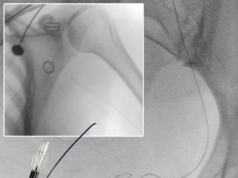Transradial, as opposed to transfemoral access, may be a safer approach for flow diversion procedures to treat cerebral aneurysms at a wide range of locations. This conclusion was reached by Yangchun Li from the University of Miami Miller School of Medicine (Miami, USA) and colleagues, as their retrospective study, published online in the Journal of NeuroInterventional Surgery (JNIS), found that both access site complication rate and overall complication rate were lower for transradial access flow diversion.
The investigators used a large multicentre registry to retrospectively analyse flow diversion cases for cerebral aneurysms from 14 institutions from 2010 to 2019. Pooled analysis of proportions was calculated using weighted analysis with a 95% confidence interval (CI) to account for results from multiple centres. Access site complication rates and overall complication rates were compared between the two approaches.
Of the 2,285 patients included in the study who underwent flow diversion, 135 (5.85%) were treated with transradial access, and 2,151 (94.14%) via transfemoral access. Li and the team reported that the two groups shared similar patient and aneurysm characteristics.
“There were no access site complication in the transradial access group,” highlight the authors. However, they write that the rate of access site complications for the transfemoral approach was 2.48% (95% CI, 2.4–2.57%, vs. 0%; p=0.039). Of note, one death resulted from a femoral access site complication.
The overall complication rate was also higher in the transfemoral group (9.02%; 95% CI, 8.15–9.89%) compared with the transradial group (3.73%; 95% CI, 3.13–4.28%; p=0.035), reported the investigators.
Why the authors are advocating for transradial access
These findings, Li et al say, help alleviate the apparent lack of neurointerventional literature directly comparing complication rates between the two approaches. Whilst the field of cardiology has conducted large randomised trials that have shown lower morbidity and mortality, as well as higher patient preference and cost reduction associated with transradial access, the same depth of investigation has yet to be applied to neuroendovascular medicine.
Moreover, Li and colleagues write: “Reducing access site complications is relevant to flow diversion for two reasons. First, flow diversion employs larger bore access systems, which may increase the likelihood of access arterial injury, bleeding or occlusion. Second, prolonged dual antiplatelet therapy is administered to patients undergoing endovascular flow diversion along with heparin, which increases the risk of access site bleeding. Additionally, the smaller diameter of the radial artery raises the question of whether a transradial access approach is uniformly feasible for flow diverting procedures.”
The investigators state that the current study is “the largest series to date comparing transradial and transfemoral access for this type of neuroendovascular procedure”. Additionally, they argue that the study demonstrates a significant safety benefit with transradial access flow diversion, alongside the feasibility of treating both ruptured and unruptured aneurysms via transradial access at a wide range of locations.
Lastly, the team surmise: “Combining both these findings with other benefits of transradial access, including high patient preferences, elimination of post-procedural bed rest and decreased cost, we continue to advocate for the transition to a radial-first approach for endovascular flow diversion.”











